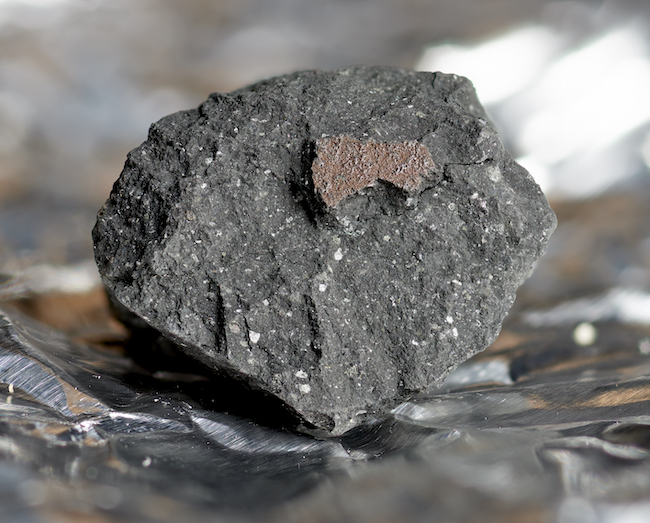University of Glasgow researchers have played a key role in the first successful recovery of a meteorite on UK soil in nearly three decades.
Dr Luke Daly, from the School of Geographical and Earth Sciences, was part of the international collaboration which tracked the entry of a fireball over Britain on Sunday 28 February.
Dr Daly is a member of the UK Fireball Alliance

Dramatic images of the fireball from across the UKFAll network, analysed with support from colleagues in other camera networks around the world, helped narrow down the meteorite’s likely landing area to near Winchcombe, in Gloucestershire.
UKFAll’s cameras were able to recreate the flight path, allowing scientists to determine exactly where in the solar system it came from, and predict where it fell. The original space rock was travelling at nearly 14km per second before hitting the Earth’s atmosphere.

The meteorite was retrieved in such a good condition, so quickly after its fall, that it is comparable to the samples returned from space missions, both in quality and quantity.
Dr Daly was part of the search party which recovered the largest intact fragment of the meteorite, alongside colleagues from universities across the UK and the Natural History Museum. The meteorite is now in the care of scientists from the Natural History Museum.
Almost 300g of the meteorite, known as a carbonaceous chondrite, survived its fiery passage through the Earth’s atmosphere and landed on a driveway in Winchcombe. Other pieces of this exceptionally rare meteorite have now been recovered in the local area.
Dr Daly said: “We expect that decent-sized meteorites strike the UK at least once a year, but the last one to be successfully recovered was found in Glatton, near Peterborough, in May 1991. Every meteorite has new and exciting things to tell us about our universe, so each one that lands without being discovered is a real missed opportunity.
“Camera networks like UKFAll were set up to take advantage of the increased availability and decreased cost of digital cameras. The hope was that we’d be able to scan the skies for fireballs, use the data from images captured from multiple angles to reconstruct their trajectory, and narrow down the area where a meteorite might have landed. Other networks, like our partners at the Global Fireball Observatory in Australia, have had great success with this approach but we couldn’t be sure that it would be as effective in the more wet and overcast UK.
“Thankfully, our efforts have been absolutely validated with this historic find. We’ve been able to recover exquisite meteorite samples just 12 hours after they landed, minimising the chances of terrestrial contamination and maximising what we can learn from them through careful analysis.
“It’s a remarkable discovery and we’re absolutely thrilled about the new research this will enable.”

Sarah McMullan, of Imperial College London's Department of Earth Science and Engineering, said: "The UK Fireball Network, which is co-coordinated by Dr Luke Daly and myself, is part of the Global Fireball Observatory run by scientists at Curtin University, Western Australia. We currently have six cameras deployed around the UK, three of which capture this exciting event and contributed data to the combined UKFAll data set. By working together, UKFAll managed to quickly calculate the orbit and potential fall location of any meteorites, get the word out to the public on what to do if you find a meteorite, and then make a speedy recovery of the meteorites. We were extremely lucky that a large meteorite fell on someone's drive so was able to be recovered within 12 hours of the fall in pristine condition. However, this event has allowed us to test out our systems, so we are ready to act quickly in the next event, and hopefully recover meteorites, even if luck isn't on our side."
Dr Ashley King, UK Research and Innovation Future Leaders Fellow in the Department of Earth Sciences at the Natural History Museum, was among the first on the scene when the meteorite was discovered on Wednesday and has been advising on the handling and care of the meteorite since. He said: “Nearly all meteorites come to us from asteroids, the leftover building blocks of the solar system that can tell us how planets like the Earth formed. The opportunity to be one of the first people to see and study a meteorite that was recovered almost immediately after falling is a dream come true!”
Dr Richard Greenwood, Research Fellow in Planetary Sciences at the Open University was the first scientist to identify and advise on the meteorite. Dr Greenwood added: “I was in shock when I saw it and immediately knew it was a rare meteorite and a totally unique event. It’s emotional being the first one to confirm to the people standing in front of you that the thud they heard on their driveway overnight is in fact the real thing.”
Once the meteorite was identified as genuine, plans were made for it to be safely moved to the Natural History Museum where it will be properly cared for until it begins an official process of classification to establish its validity and scientific significance.
A team of specialist scientists from across the UK have been successfully searching the rest of the predicted fall area for more fragments including colleagues from The University of Glasgow, The University of Manchester, The Open University, The University of Plymouth, and Imperial College London.
Professor Phil Bland, the Director of the Space Science and Technology Centre at Curtin University leading the Global Fireball Observatory, says “This is in true spirit of what we set out to do when we established the GFO collaboration – recovering rare meteorites with known orbits. It is an incredible first recovery for our UK colleagues and a fantastic demonstration of the unprecedented power of collaboration in unravelling the mysteries of our solar system.”
There are approximately 65,000 known meteorites on Earth. Only 1,206 have been witnessed to fall and of these only 51 are carbonaceous chondrites. Of these, only 51 of them are carbonaceous chondrites. This is the first known carbonaceous chondrite to have been found in the UK, and the first meteorite recovered in the UK in 30 years. The last meteorite that was discovered in the UK was the Glatton meteorite that landed in a residential garden in 1991.
A victory for UK citizen science, the fireball was seen by thousands of eyewitnesses across the UK and northern Europe, many of whom reported it to the UK Meteor Observation Network, and was captured on many fireball cameras and home surveillance cameras when it fell to Earth at 21:54 on Sunday 28 February.
Meteorites are incredibly old – their age of about 4,567 million years is much older than any rock from the Earth. Almost all these “space rocks” have been blasted off asteroids, and travel for many thousands of years through space before being captured – usually by the Sun, but occasionally by Earth. They travel through the atmosphere, sometimes – like the one that fell in Gloucestershire – producing a bright fireball before landing on Earth. Over 1000 meteorites the size of a football are believed to fall to Earth every year, however it is very rare for any of them to be seen to fall and recovered.
Carbonaceous chondrites, like the one just discovered, are made of a mixture of minerals and organic compounds – including amino acids. They are the most primitive and pristine materials of the solar system and can provide unique information on where water and the building blocks of life were formed and what planets are made from - some of the biggest questions asked by the scientific community.
Prof Sara Russell, Merit Researcher in Cosmic Mineralogy at the Natural History Museum advised on the care of the meteorite once it was located. Prof Russell said: “The Japanese space mission Hayabusa2 returned around 4.5 g of fragments from asteroid Ryugu to Earth in December last year, and at the Museum we are helping to characterise this material. The Winchcombe meteorite fall is very timely as the rock is similar to Ryugu in many ways, and we can use the meteorite to rehearse for mission analyses.”
Jim Rowe of UKFAll said: “Three years ago a meteorite fell in Dorset. Back then we had good data but no action plan. So, we set up UKFAll, and this is the outcome! Each of the six UK meteor camera networks contributed data as did three international teams who analysed the data, so it’s been a real global collaborative effort tracking down this important meteorite.”

No comments:
Post a Comment